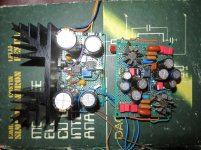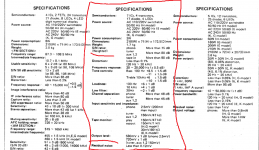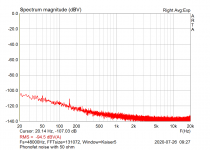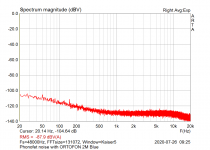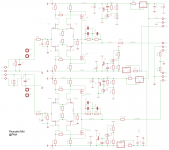You miss out the bipolar current noise. If you SHORT the input of the phono amp out then you can get very good figures with a bipolar input stage. When you connect the cartridge it’s gone.
You cannot consider MM noise without the cartridge L and R - Scott Wurcer has shown this as well.
See here for a spread shot to calculate noise (Derived from Stuart Yaniger’s spread sheet).
So Just How Quiet is Your Phono Stage?
You cannot consider MM noise without the cartridge L and R - Scott Wurcer has shown this as well.
See here for a spread shot to calculate noise (Derived from Stuart Yaniger’s spread sheet).
So Just How Quiet is Your Phono Stage?
Last edited:
Sy has a very nice spread sheet based on the Natsemi noise app note that calculates the noise contribution of the cart + load combo.
I have a nice rule of thumb: minimize the spot noise at 3852 Hz and the RIAA- and A-weighted total noise will also be minimized. It works quite well when white noise dominates and there is hardly any correlation between the equivalent input noise voltage and current.
You people miss out the bipolar current noise. If you SHORT the input of the phono amp out then you can get very good figures. When you connect the cartridge it’s gone.
You cannot consider MM noise without the cartridge L
Indeed, that's also what I wrote in post #20 point 2. That's why the optimal bias current for a bipolar MM input stage will normally be in the 20 to 60 uA range.
You people miss out the bipolar current noise. If you SHORT the input of the phono amp out then you can get very good figures. When you connect the cartridge it’s gone.
You cannot consider MM noise without the cartridge L and
R
Definitely. That's it.
With a 2sa1038e(whch i am going to use soon in one of my preamps) which is having a HFE =600 working at Ic=700ua(0.7ma) that should not be difficult at all...i'm just remaking the AIWA c22 preamp supplied at +-20v with some modifications that should hopefully work and chose that transistor just to see if it's any better than the original 2sa991...I made this choice after comparing the j-fet stage used in marantz pm62 (supplied at +-18v and modified back to the original technics su-v6)with the aiwa and the noise wasn't the issue, both preamps were equally silent, but the bipolar input aiwa although supplied at +-15 behaved way better including on dusty records where the technics collapsed completely at 33rpm.Only when hiting the 45RPM the Marantz j-fet preamp sounded right with noise so it must be something about the way it clips as at 45RPM the S/N ratio the distortion pattern can be hidden. Aiwa was the best under all circumstance and i know what i'm talking about because my standard is still a d3a preamp able to reproduce perfect square waves up to 25khz through the antiriaa and riaa filters with very faint hum only when the cartridge wasn't connected to the input.Indeed, that's also what I wrote in post #20 point 2. That's why the optimal bias current for a bipolar MM input stage will normally be in the 20 to 60 uA range.
Last edited:
I have a nice rule of thumb: minimize the spot noise at 3852 Hz and the RIAA- and A-weighted total noise will also be minimized. It works quite well when white noise dominates and there is hardly any correlation between the equivalent input noise voltage and current.
I remember that from another thread! Do you have any workings to show the underpinnings of this?
Don’t doubt you, but would like to know how you got there.
dreamth, sorry, I meant the optimal collector current, not the base current. For a 500 mH cartridge, hFE = 600, small base resistance and optimizing the RIAA- and A-weighted noise, ICopt ~= 52 uA.
I remember that from another thread! Do you have any workings to show the underpinnings of this?
See the attachment, which is a small part of the article in Linear Audio vol. 8 I referred to earlier. As far as I recall, I never officially transferred the copyright, so I guess I can quote myself.
Attachments
@ Marcel
i just modified my previous post...
the original collector current in AIWA is 700ua(0.7ma)
52ua collector current is the LM194 territory or internal input transistors in ne5534 maybe...I have them too, but now i go with the pnp bipolar transistors.It's not hard to change the pnp design to a npn design and try the LM194, but i know i'm really pleased with the aiwa design .
Honestly, if would have been more pleased with the fet version which is pretty close to Vogel version i would have gone with it, but this is not something i do for sale, is smth i do for myself using the best resources i can think of(2sa1038 are the pink painted transistors circled with orange in the photo).They are having that pink paint from the factory .I also have the usual 2sa1038, but these are the best low noise transistors i could ever find.
i just modified my previous post...
the original collector current in AIWA is 700ua(0.7ma)
52ua collector current is the LM194 territory or internal input transistors in ne5534 maybe...I have them too, but now i go with the pnp bipolar transistors.It's not hard to change the pnp design to a npn design and try the LM194, but i know i'm really pleased with the aiwa design .
Honestly, if would have been more pleased with the fet version which is pretty close to Vogel version i would have gone with it, but this is not something i do for sale, is smth i do for myself using the best resources i can think of(2sa1038 are the pink painted transistors circled with orange in the photo).They are having that pink paint from the factory .I also have the usual 2sa1038, but these are the best low noise transistors i could ever find.
Attachments
700 uA is way above the noise optimum, even with hFE = 600, but the effect is still not dramatic.
With 700 uA collector current and hFE = 600, the base current is 1.1666... uA and the shot noise associated with the base current is approximately 0.61143 pA/sqrt(Hz). With a 500 mH cartridge at 3852 Hz, that will have about the same effect on the total noise as a noise voltage of 7.4 nV/sqrt(Hz).
However, when the 47 kohm termination resistance is made by simply shunting the input with a 47 kohm resistor, the effect of its thermal noise is in the same ballpark. The thermal noise of a typical cartridge is also of the same order when you take into account the frequency dependence of its resistance.
All in all, assuming no electronic cooling of the 47 kohm termination, the noise floor with no record playing will increase by at most 2 dB(A) compared to a similar amplifier with optimal input transistor collector current. With a record playing, the difference will be much smaller.
With 700 uA collector current and hFE = 600, the base current is 1.1666... uA and the shot noise associated with the base current is approximately 0.61143 pA/sqrt(Hz). With a 500 mH cartridge at 3852 Hz, that will have about the same effect on the total noise as a noise voltage of 7.4 nV/sqrt(Hz).
However, when the 47 kohm termination resistance is made by simply shunting the input with a 47 kohm resistor, the effect of its thermal noise is in the same ballpark. The thermal noise of a typical cartridge is also of the same order when you take into account the frequency dependence of its resistance.
All in all, assuming no electronic cooling of the 47 kohm termination, the noise floor with no record playing will increase by at most 2 dB(A) compared to a similar amplifier with optimal input transistor collector current. With a record playing, the difference will be much smaller.
See the attachment, which is a small part of the article in Linear Audio vol. 8 I referred to earlier. As far as I recall, I never officially transferred the copyright, so I guess I can quote myself.
Thank you- I’ll have to go through that
Marcel, if I understand your derivation, in an RIAA EQ preamp, A weighted measurement, you are saying if the integrated current noise component x the source z alcove 3852 Hz equals the integrated voltage noise component below 3852 Hz then the system noise is lowest ie the pivot point is the spot noise at 3852 Hz yes?
Last edited:
Not that I'm aware of. I just say that whatever combination of equivalent input current and voltage noise gives the lowest total noise at 3852 Hz also gives the lowest integrated RIAA- and A-weighted noise, because the ratio between the noise at 3852 Hz and the integrated RIAA- and A-weighted noise is independent of what part comes from the equivalent input current and what part from the equivalent input voltage noise.
Please let me demonstrate the effect of MM cartridge to output noise of the MM preamplifier. The preamp is my Phonofet with JFET input. Measurements are made at the preamp output. Input of the preamp is shorted by 50 ohm and in 2nd measurement Ortofon 2m blue cartridge is used. Vrms measurement is calibrated and shown with A weight. Preamp gain is 36dB at 1kHz.
Attachments
Pretty much the same sort of figures I am seeing Pavel. The difference between the shorted reading and with a real world load is significant.
Yes, it is. And then put the cartridge on an empty groove and then we can see that we do not need to care so much about the preamp noise. It is only an engineering challenge 😉. In a real world of vinyl records, we can get S/N about 60dB(A).
So there's no solid proof of fet input being better than bjt input in the real world of phono preamplificatio which is a clar statement that expensive fet phono preamps are useless and that is all i needed to hear from you 🙂Yes, it is. And then put the cartridge on an empty groove and then we can see that we do not need to care so much about the preamp noise. It is only an engineering challenge 😉. In a real world of vinyl records, we can get S/N about 60dB(A).
Your graphs claim of having identical noise of the entire phono chain with the johnson noise of the cartridge itself at 1000 hz...Please let me demonstrate the effect of MM cartridge to output noise of the MM preamplifier. The preamp is my Phonofet with JFET input. Measurements are made at the preamp output. Input of the preamp is shorted by 50 ohm and in 2nd measurement Ortofon 2m blue cartridge is used. Vrms measurement is calibrated and shown with A weight. Preamp gain is 36dB at 1kHz.
Last edited:
- Status
- Not open for further replies.
- Home
- Source & Line
- Analogue Source
- FET vs BJT input phono preamp
